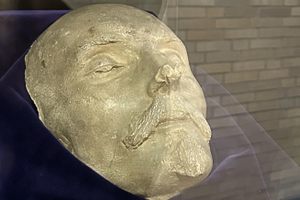
It’s one of the most famous Shakespearian mysteries: what did the Bard actually look like? None of the iconic portraits of history’s most revered playwright are known to be authentic likenesses.
The image of Shakespeare that most of us have imprinted in our minds is a combination of facets from various doubtful sources. The true face of the man behind Hamlet, Macbeth, and King Lear may well have been lost to time.
Or, you might be able to see it at the end of a low-traffic hallway in a library at the Technical University of Darmstadt.
As of 2024, this alleged death mask of William Shakespeare sits in a satin-lined display case — one of several in this hallway — marked by absolutely no wayfinding signage. A plaque on the wall identifies the wondrous object matter-of-factly as “William Shakespeare Totenmaske 1616.” Nothing in the vicinity acknowledges how globe-shatteringly important the mask would be, if it were genuine. Also, nothing in the vicinity offers any context at all about the scholarly debate over whether it actually is.
On one hand: in Shakespeare’s time, death masks were rarely made of non-royals. And it has proven difficult to trace the mask’s provenance back to England. On the other: an examination by a German eye specialist concluded that the swelling around the left eye is consistent with other possible images of Shakespeare, and with a rare cancer that he may have died from.
Literature enthusiasts flock to displays of Shakespearean ephemera: the 235 extant copies of the First Folio, the handful of dubious portraits, the infamous will in which he left his wife only the “second-best bed.” If you can quiet your doubts for a moment, the death mask might upstage them all: a record of the Bard’s end.
0 comments:
Post a Comment